Low Vitamin D during pregnancy identified with just 5 questions (for less than 12 ng)
A validated screening tool correctly identifies the majority of pregnant women at high risk of vitamin D deficiency
Clin Nutr ESPEN. 2022 Jun;49:301-306. doi: 10.1016/j.clnesp.2022.03.034.
Linnea Bärebring 1, Anna Amberntsson 2, Hanna Augustin 3

Background & aim: The objective was to develop and validate a non-invasive screening tool to identify pregnant women at high risk of vitamin D deficiency.
Methods: Data from the Swedish prospective cohort GraviD, 2125 pregnant women, were randomly split in halves; one for developing the screening tool, and one for validation. Risk factors of vitamin D deficiency (serum 25-hydroxyvitamin D < 30 nmol/L) were identified using logistic regression analyses and odds ratios were translated into scores. Cutt offs to indicate high risk of vitamin D deficiency were evaluated by receiver operator characteristics.
Results: Five variables (
season,
clothing,
eye color (was better than skin color)
fortified milk intake and
vitamin D supplement use)
were included in the screening tool. The possible total score was 0-42. Mean (95% CI) area under the curve for classification of vitamin D deficiency was 0.921 (0.893-0.948) (p < 0.001). A score of ≥15 points had 92% sensitivity and 76% specificity to identify women with 25OHD <30 nmol/L. This cut off had a positive predictive value of 31% and a negative predictive value of 99%.
Conclusion: This short non-invasive screening tool is valid as it correctly identified the majority of the vitamin D deficient pregnant women, who may benefit from further investigation for definite diagnosis and subsequent treatment.
📄 Download the PDF from Vitamin D Life
Only 1% of the time did the screening tool fail to identify a woman having <12 ng
Vitamin D Life - Predict Vitamin D category contains
{include}
